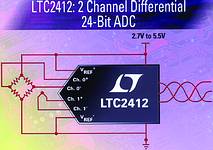2-channel differential input 24-bit ADC
26 March 2003
Analogue, Mixed Signal, LSI

The LTC2412 is a 2-channel differential input micropower 24-bit no latency delta-sigma analog-to-digital converter with an integrated oscillator. Manufactured by Linear Technology, it provides 2 ppm INL and 0,16 ppm RMS noise over the entire supply range.
The two differential channels are converted alternately with channel ID included in the conversion results. It uses delta-sigma technology and provides single conversion settling of the digital filter.
Through a single pin, the LTC2412 can be configured for better than 110 dB input differential mode rejection at 50 Hz or 60 Hz ±2%, or it can be driven by an external oscillator for a user defined rejection frequency. The internal oscillator requires no external frequency setting components.
The converter accepts any external differential reference voltage from 0,1 V to VCC for flexible ratiometric and remote sensing measurement configurations. The full-scale differential input range is from -0,5 VREF to 0,5 VREF. The reference common mode voltage, VREFCM and the input common mode voltage, VINCM may be independently set anywhere within the GND to VCC. The DC common mode input rejection is better than 140 dB.
The LTC2412 communicates through a flexible 3-wire digital interface, which is compatible with SPI and Microwire protocols.
Further reading:
Online sensor technology hub
Analogue, Mixed Signal, LSI
Mouser’s sensor content hub offers an extensive collection of articles, blogs, eBooks, and product information from its technical experts and leading manufacturing partners.
Read more...
Ultra-low power MEMS accelerometer
Altron Arrow
Analogue, Mixed Signal, LSI
Analog Devices’ ADXL366 is an ultra-low power, 3-axis MEMS accelerometer that consumes only 0,96 µA at a 100 Hz output data rate and 191 nA when in motion-triggered wake-up mode.
Read more...
BT Audio 4 Click board
Dizzy Enterprises
Analogue, Mixed Signal, LSI
The BT Audio 4 Click board from MIKROE provides high-quality wireless audio streaming and data comms over Bluetooth.
Read more...
Precision MEMS IMU modules
Altron Arrow
Analogue, Mixed Signal, LSI
The ADIS16575/ADIS16576/ADIS16577 from Analog Devices are precision, MEMS IMUs that includes a triaxial gyroscope and a triaxial accelerometer.
Read more...
MEMS with embedded AI processing
Altron Arrow
Analogue, Mixed Signal, LSI
STMicroelectronics has announced an inertial measurement unit that combines sensors tuned for activity tracking and high-g impact measurement into a single, space-saving package.
Read more...
High-performance IMU
RS South Africa
Analogue, Mixed Signal, LSI
TDK Corporation has announced availability of the new InvenSense SmartMotion ICM-536xx family of high-performance 6-axis IMUs.
Read more...
High-temperature closed-loop MEMS accelerometer
RS South Africa
Analogue, Mixed Signal, LSI
This sensor from TDK is a high-temperature MEMS accelerometer with ±14 g input range and a digital interface for measurement while drilling applications.
Read more...
Dual accelerometers on the same die
Altron Arrow
Analogue, Mixed Signal, LSI
The LSM6DSV320X is the first mainstream inertial sensor to house a gyroscope alongside two accelerometers, one capable of sensing up to ±16 g and one sensing up to a staggering ±320 g.
Read more...
Dual-range IMU with edge processing
EBV Electrolink
Analogue, Mixed Signal, LSI
ST’s innovative LSM6DSV80X combines two accelerometer structures for 16 g and 80 g full-scale sensing, a gyroscope up 4000 dps, and embedded intelligence in a single component.
Read more...
High-reliability isolation amplifiers
EBV Electrolink
Analogue, Mixed Signal, LSI
The VIA series of isolation amplifiers from Vishay are designed to deliver exceptional thermal stability and precise measurement capabilities.
Read more...


